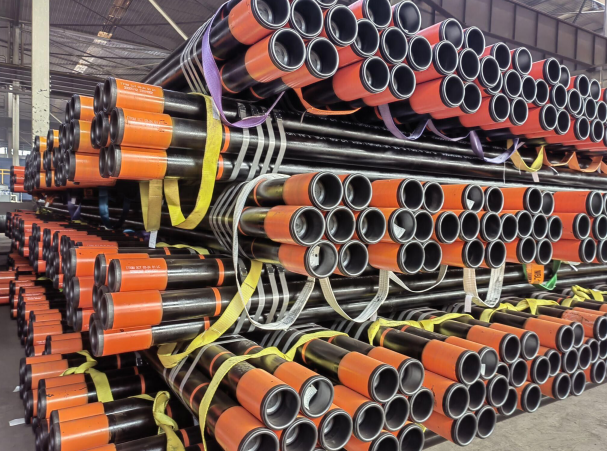
Causes and Types of Oil Well Casing Damage
Date:2024-03-29 keywords: oil well casing damage, well casing damage types and causes, octg casing pipe
Oil well casing is a barrier that isolates the formation from the wellbore during drilling. In heavy oil thermal recovery wells, casing damage is particularly common. The main damage is manifested in extrusion deformation, distortion, etc.
The damage mechanism is:
1. Effect of temperature: a. When the temperature rises, the strength of the casing itself decreases; b. When the temperature rises, the casing expands, causing compressive stress and bending stress in the casing to reduce the strength; c. When the temperature rises, the annulus fluid expands This results in an increase in internal pressure, thereby reducing the strength of the casing.
2. Fatigue damage: The rise in temperature causes the casing to stretch, resulting in tensile and compressive stress. This stress is cyclic and causes fatigue damage to the casing.
3. Slippage damage: The cement sheath and casing will slip due to the increase in temperature, causing the casing to hit the bottom of the well and be deformed and damaged.
Causes of oil well casing damage:
1. Mechanical wear: The casing continuously moves up and down in the oil well bore and rubs against the well wall, gradually causing wear. Moreover, oil wells contain hard objects such as sand, which will cause more obvious wear to the casing.
2. Corrosion damage: Casings must withstand the corrosive effects of various acids, alkalis, salts and other chemical substances in oil wells. Corrosion damage will occur over time.
3. Damage from external forces: During long-term operation of casing in oil wells, it will inevitably be impacted by some external forces, such as drill bit impact, worker smashing, etc.
4. Thermal expansion and contraction: Oil wells will produce high and low temperatures during production, so the casing will expand and contract with heat, which will cause damage to the casing over time.
5. Strategic damage: Casing damage caused by certain human factors, such as improper operation of mechanical equipment, worker errors, etc.
Types of oil well casing damage:
1. Scratches: longitudinal or spiral grooves are scratched out on the surface of the casing.
2. Wear: The surface of the casing is ground into a boss-shaped or oval groove.
3. Corrosion: Traces of chemical corrosion appear on the metal on the surface of the casing, and rust spots or holes appear on the surface of the casing.
4. Break: The metal on the surface of the casing appears to be broken, and the inner wall appears as cracks and fractures.
5. Distortion: The casing is acted upon by external forces, resulting in bending and torsional deformation.
6. Fracture: Cracks appear longitudinally or transversely in the casing, causing the casing to break.
Conclusion:
The damage mechanism is:
1. Effect of temperature: a. When the temperature rises, the strength of the casing itself decreases; b. When the temperature rises, the casing expands, causing compressive stress and bending stress in the casing to reduce the strength; c. When the temperature rises, the annulus fluid expands This results in an increase in internal pressure, thereby reducing the strength of the casing.
2. Fatigue damage: The rise in temperature causes the casing to stretch, resulting in tensile and compressive stress. This stress is cyclic and causes fatigue damage to the casing.
3. Slippage damage: The cement sheath and casing will slip due to the increase in temperature, causing the casing to hit the bottom of the well and be deformed and damaged.
4. Sand production: Heavy oil wells have serious sand production, and sand particles contribute greatly to casing wear.

Causes of oil well casing damage:
1. Mechanical wear: The casing continuously moves up and down in the oil well bore and rubs against the well wall, gradually causing wear. Moreover, oil wells contain hard objects such as sand, which will cause more obvious wear to the casing.
2. Corrosion damage: Casings must withstand the corrosive effects of various acids, alkalis, salts and other chemical substances in oil wells. Corrosion damage will occur over time.
3. Damage from external forces: During long-term operation of casing in oil wells, it will inevitably be impacted by some external forces, such as drill bit impact, worker smashing, etc.
4. Thermal expansion and contraction: Oil wells will produce high and low temperatures during production, so the casing will expand and contract with heat, which will cause damage to the casing over time.
5. Strategic damage: Casing damage caused by certain human factors, such as improper operation of mechanical equipment, worker errors, etc.
Types of oil well casing damage:
1. Scratches: longitudinal or spiral grooves are scratched out on the surface of the casing.
2. Wear: The surface of the casing is ground into a boss-shaped or oval groove.
3. Corrosion: Traces of chemical corrosion appear on the metal on the surface of the casing, and rust spots or holes appear on the surface of the casing.
4. Break: The metal on the surface of the casing appears to be broken, and the inner wall appears as cracks and fractures.
5. Distortion: The casing is acted upon by external forces, resulting in bending and torsional deformation.
6. Fracture: Cracks appear longitudinally or transversely in the casing, causing the casing to break.
Conclusion:
The above are the causes and types of oil well casing damage. Oil workers should pay attention to avoid casing damage when maintaining and operating oil wells, and repair and replace them in a timely manner. At the same time, the operating conditions of oil wells and casings are regularly tested to ensure safe and stable production of oil wells.
Read more: Oil Casing Pipe Maintenance and Anti-corrosion Countermeasures
©2017 Permanent Steel Manufacturing Co.,Ltd https://www.permanentsteel.com All Rights Reserved.
Terms of Sale|Privacy Policy


